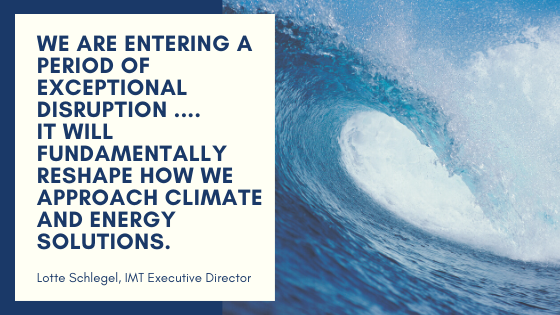
To our partners, colleagues, and stakeholders:
As we wrap up 2019, I’d like to pause for a moment to reflect on recent accomplishments and discuss how the Institute for Market Transformation (IMT) is approaching some big changes I see emerging in the decade ahead.
As many of you know, I was thrilled to step into the IMT executive director role a few months ago. From day one, I’ve considered this a two-part opportunity. The first is maintaining and strengthening IMT’s programmatic excellence, wonderful work culture, and remarkable partnerships with individuals like you and your organizations. These are the defining elements of IMT, cultivated over 20+ years by our world-class staff and board of directors, as well as the outstanding leadership of Cliff Majersik, the past IMT executive director who remains part of our senior leadership team.
Having these pieces in place makes all the difference, so it’s no surprise that IMT had an extraordinary year. We are grateful to you, our colleagues and funders, for our shared success. Buildings are responsible for over one third of U.S. emissions and our focused work in 2019 made a real impact. Early next year, we’ll provide more about our 2019 achievements to drive down these emissions. However, here are a few highlights we’re particularly proud of:
- Our decarbonization work with leading U.S. cities is achieving more than ever. We are proud to partner with more than five dozen local governments to drive new policies and deeper engagement with the business community that will bring financially viable, energy-saving solutions to the market and eliminate energy waste and carbon emissions from new and old buildings.
- Our work with global real estate companies and businesses is more productive than ever. We are diving into the toughest challenges of companies working to improve their buildings, bringing businesses together to break free from business as usual to design game-changing solutions that benefit both climate and business, and recognize and replicate the progress leading companies are making.
- We are changing and learning—as individuals and as an organization—to better integrate social priorities into our building performance mission. I am proud of our team’s dedication to change and our partnerships with organizations working to bring racial equity, affordability, health, and economic and environmental resilience into the DNA of IMT’s building performance mission.
The second opportunity ahead is assessing how the world around us is changing and determining how IMT must evolve to be most effective at advancing energy efficiency and reducing dangerous carbon pollution. This may sound straightforward, but it’s actually an enormous challenge. Let me explain why.

Embracing Disruption
We are entering a period of exceptional disruption in many of the areas in which IMT and our peer organizations operate—energy technology, climate policy, real estate, and utilities. For example, our homes are transforming into distributed power plants through renewable energy, and into fueling stations through electric vehicle charging infrastructure. Our buildings are communicating in new ways with the electric grid and responding to real-time grid signals. Major cities and companies are committing to 100% clean power and promoting the mass electrification of buildings and appliances. Large-scale batteries and energy storage technologies are becoming commercially available for the first time. Underpinning all of this is a drive to optimize efficiency and energy use, which our partners at the Energy Foundation recently tackled in a five-part blog series.
This disruption is unbelievably broad and moving incredibly fast. Over the next decade, it will fundamentally reshape how we approach climate and energy solutions related to our physical environment and redefine how buildings contribute to climate protection, resiliency, housing affordability, public health, racial equity, and many other societal priorities.
Disruption creates opportunity. For IMT to continue to thrive and make important contributions through our work, a few things are coming into focus. First, the value proposition for energy efficiency is changing. In a world of low-cost renewables, grid-responsive buildings, electrified end uses and energy storage, energy efficiency can’t be a stand-alone approach—it must serve as the critical enabler that makes an ecosystem of advanced approaches economically viable and scalable. Second, we need to think more expansively and inclusively about “building performance.” In the past, we’ve used this term principally to mean a structure’s energy consumption and carbon profile. In the future, we need to consider the holistic environmental and social dimensions of how a building impacts its community—the people inside of it and the world around it.
Those are big shifts, but IMT is up to the challenge. Next year, we’re launching a 10-year initiative to unlock the power of our buildings to address the urgent challenges of the 21st century. It will include dynamic building policy models that unite climate, equit,y and affordability outcomes, as well as pioneering business frameworks that rethink how we leverage standard real estate transactions to the benefit of occupants and communities. These innovations build on our outstanding work with global real estate investors and Fortune 500 companies to cultivate market leadership, and our extraordinary support of cities and states to redefine policy leadership. They push the boundaries of what’s possible, which is where IMT has always felt most at home.
For IMT, next year is about action, scale, urgency, and innovation. On behalf of IMT, thank you so much for being part of this incredible journey with us. We’ll see you out there in 2020!
Lotte Schlegel
IMT Executive Director
